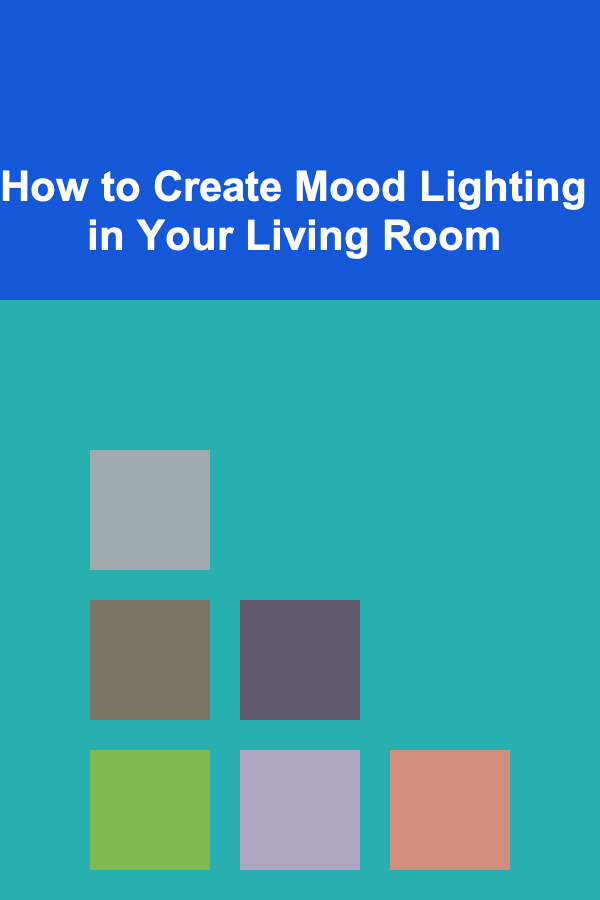
How to Create Mood Lighting in Your Living Room
ebook include PDF & Audio bundle (Micro Guide)
$12.99$11.99
Limited Time Offer! Order within the next:

Lighting is one of the most powerful tools in interior design. The way you light a room can drastically influence its atmosphere and the emotions of those who experience it. When it comes to creating a cozy, inviting, and stylish living room, mood lighting plays a crucial role. It can transform the energy of a space, from vibrant and lively to calm and relaxing. In this article, we will explore how to effectively use mood lighting in your living room, providing tips and techniques to enhance the ambiance of your space.
Understanding Mood Lighting
Before diving into how to create mood lighting, it's essential to understand what mood lighting is and how it differs from general lighting.
What is Mood Lighting?
Mood lighting is a type of lighting designed to evoke a particular emotional response or create a specific atmosphere. Unlike task lighting, which is focused on functionality (like reading or cooking), mood lighting is meant to alter the overall feel of a room. It's subtle and often soft, casting a warm or cool glow that promotes relaxation, socialization, or even creativity.
In a living room, mood lighting can be used to highlight certain features of the space, create depth, or set the mood for a variety of occasions---whether it's a cozy movie night, a lively gathering with friends, or a quiet evening of reading.
Why is Mood Lighting Important?
The importance of mood lighting cannot be overstated. Light has a profound effect on our emotions and overall well-being. Poor lighting can lead to a space feeling either too sterile or overly harsh, which can negatively impact our mood and comfort. On the other hand, well-executed mood lighting makes a room feel warmer, more inviting, and relaxing.
By adjusting the intensity, direction, and color temperature of your lighting, you can create a space that reflects your desired ambiance and supports the functions of your living room. Whether you're entertaining guests, enjoying a meal with family, or simply unwinding after a long day, the right mood lighting can help to enhance the experience.
Key Elements of Mood Lighting
To successfully create mood lighting, there are several key elements you should consider. These elements, including light sources, placement, intensity, and color temperature, all play an essential role in crafting the right atmosphere in your living room.
1. Layering Light
One of the most important aspects of creating mood lighting is layering different types of light. By combining multiple light sources at different levels, you can achieve a balanced and dynamic lighting scheme that enhances the room's ambiance.
There are three main layers of lighting to consider:
- Ambient Lighting: This is the general light that illuminates the entire room. Ambient lighting provides a soft, even glow that helps to establish the foundation of the mood. It can be achieved through ceiling lights, recessed lighting, chandeliers, or soft wall-mounted fixtures.
- Task Lighting: This type of lighting is used to focus light on specific tasks such as reading, writing, or working. While task lighting is more functional, it can still be adjusted to create a cozy environment. Desk lamps, floor lamps, and table lamps are popular sources of task lighting in a living room.
- Accent Lighting: Accent lighting is used to highlight particular features in the room, such as artwork, plants, architectural details, or decorative elements. Spotlights, track lighting, and sconces are often used for accent lighting. This layer adds depth and drama to a space, making it feel more interesting and inviting.
By using a combination of ambient, task, and accent lighting, you can create a mood that fits your needs and the activity taking place.
2. Light Intensity and Brightness
The intensity of light plays a significant role in setting the tone of a room. Dim lighting is often associated with relaxation and calm, while bright lighting tends to create a more energetic and lively atmosphere.
To achieve the perfect mood lighting, you can use dimmer switches or smart lighting systems that allow you to adjust the brightness according to the time of day or the activity. For instance, if you're hosting a dinner party, you might want brighter lights to encourage conversation, while a dimmed setting is ideal for a quiet, intimate evening.
3. Color Temperature
The color temperature of your light bulbs can greatly impact the mood of a room. Color temperature is measured in Kelvins (K), and it describes the warmth or coolness of light. There are two primary categories:
- Warm Light (Below 3000K): Warm light is soft and inviting. It's perfect for creating a cozy and relaxing atmosphere in your living room, making it ideal for evening relaxation or social gatherings. Warm light tends to have a yellowish or amber hue that mimics the warmth of natural sunlight during sunset.
- Cool Light (Above 4000K): Cool light is bright and crisp, often associated with daylight. It creates an energetic and focused atmosphere, making it great for task-oriented activities such as reading or working. However, cool light may not always be suitable for mood lighting, as it can make a room feel colder and more sterile.
To create a soothing, inviting atmosphere in your living room, stick to warm light tones. These are perfect for setting a relaxing and intimate mood.
4. Direction of Light
The direction in which light is cast in your living room can alter its mood. Direct light tends to create harsh shadows and can feel intense or dramatic, whereas indirect light produces a softer, more diffused glow that feels more inviting and calming.
There are several ways to control the direction of light:
- Wall-mounted lights: Lights that point toward the walls or ceiling provide indirect lighting that gently reflects light into the room, creating a soft and ambient atmosphere.
- Lamps: Positioning table lamps, floor lamps, or pendant lights in strategic locations ensures that light is directed in ways that complement the space and encourage the desired mood.
- Adjustable lighting: Using adjustable lamps or fixtures with moveable heads allows you to control the direction of the light, giving you more flexibility in how you shape the room's atmosphere.
By controlling the direction of light, you can eliminate harsh contrasts and ensure a soft, flattering ambiance.
Different Lighting Techniques for Mood Enhancement
Now that we've covered the basic elements of mood lighting, let's explore some practical techniques for creating the perfect atmosphere in your living room.
1. Use of Dimmer Switches
Dimmer switches are a great tool for controlling the intensity of light and setting the mood in your living room. By adjusting the brightness of your light fixtures, you can transition from bright, task-focused lighting to a soft, romantic glow in seconds. Dimmer switches allow you to fine-tune the ambiance, creating a space that adapts to your needs at any given time.
For example, during a movie night, you can dim the lights to create a theater-like atmosphere. Alternatively, if you're hosting a lively gathering, you can increase the brightness to encourage interaction and activity.
2. Highlighting Architectural Features
Accent lighting can be used to highlight architectural elements in your living room, such as a beautiful fireplace, shelving, or a statement piece of furniture. Wall sconces, track lighting, or directional floor lamps can all be used to draw attention to these features, creating a visually interesting focal point in the room.
This technique also adds depth to the space, making the room feel larger and more dynamic. By strategically placing lights to illuminate certain features, you add an element of sophistication and style to your mood lighting.
3. Layering with LED Strip Lights
LED strip lights are versatile and can be used in a variety of ways to enhance mood lighting. These lights can be placed along the edges of shelves, under furniture, or even around the perimeter of the ceiling for an ambient glow. LED strips are available in a wide range of colors, and many are dimmable or programmable, allowing you to customize the color and intensity of the light.
For example, you can use soft white LED strips to create an ethereal glow around the edges of your living room, or you can opt for colored LED strips to add a touch of drama for a more contemporary, playful vibe.
4. Using Lamps for Soft Lighting
Table lamps and floor lamps are fantastic sources of soft, ambient light in the living room. When choosing lamps, select ones with fabric or frosted glass shades to diffuse the light and prevent harsh glares. Placing multiple lamps around the room allows for better light distribution and prevents areas from feeling too dim or too bright.
You can also experiment with the positioning of the lamps. For example, placing a lamp in a corner can create a cozy nook, while placing two lamps on either side of a sofa can help achieve a sense of balance and symmetry.
5. Candlelight for Intimacy
Candlelight is one of the most effective and romantic ways to create mood lighting. Whether you opt for traditional candles or LED flameless versions, the soft flicker of candlelight adds a warm and intimate atmosphere to any living room.
Candles can be placed on coffee tables, mantlepieces, or side tables to enhance the mood. For even more effect, you can use candle holders or lanterns to add decorative elements to the lighting scheme.
6. Incorporating Natural Light
Natural light, when used strategically, can also play a role in mood lighting. Large windows or glass doors allow sunlight to filter into the room, creating an airy and bright atmosphere during the day. The key to using natural light is to incorporate it thoughtfully. Consider the direction of the sun and how it affects the space throughout the day.
During the morning and afternoon, natural light can help create an uplifting, energizing atmosphere, while in the evening, as the light dims, you can transition to artificial mood lighting to create a more relaxing ambiance.
Conclusion
Creating mood lighting in your living room is all about balancing light intensity, color, direction, and the use of various light sources to enhance the atmosphere. With the right lighting techniques, you can transform your living room into a space that feels comfortable, inviting, and reflective of your personal style. Whether you prefer soft and cozy lighting for relaxation or bright and energetic lighting for socializing, mood lighting allows you to adapt the room to your needs and set the perfect tone for any occasion. Experiment with different combinations of lighting sources, and remember that the beauty of mood lighting lies in its flexibility and ability to shape the emotional atmosphere of the space.

How to Make Energy-Efficient Upgrades to Your Home Rental Property
Read More
How to Organize Holiday Decorations for Easy Storage
Read More
How to Set Up an Emergency Fund for Unexpected Expenses
Read MoreHow to Set Up UTM Parameters for Accurate Tracking of Influencer Campaigns
Read More
Preventing Workplace Hazards: Strategies and Best Practices for Health and Safety Officers
Read More
Why Organizing Your Space Can Lead to Better Focus
Read MoreOther Products

How to Make Energy-Efficient Upgrades to Your Home Rental Property
Read More
How to Organize Holiday Decorations for Easy Storage
Read More
How to Set Up an Emergency Fund for Unexpected Expenses
Read MoreHow to Set Up UTM Parameters for Accurate Tracking of Influencer Campaigns
Read More
Preventing Workplace Hazards: Strategies and Best Practices for Health and Safety Officers
Read More